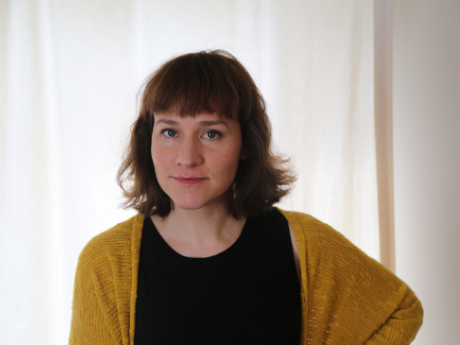Award Winners
Alice Fay Di Castagnola Award - 2021
Kathryn Cowles

Moon. Eleanor Eleanor. Oil on canvas. 2018
This painting has no moon to see in it.
This painting has no flecks of snow,
no visible stars, no white point.
The reflection of the moon
has been unlaced from the lake in this painting
and so this painting has no lake to see.
The visible night lake
was always part moon
and there’s no moon.
What of moon there is in this painting
one has to see some other way.
What of moon there is can be sensed
the way tiny nightblooming flowers
can be sensed beyond the dark door just
before you step into their wall of smell.
You can feel the edge of the smell,
the green fists of bud uncapping their whole
perfume bottles full of dark white
into the heavy air, a liquid mixed with another liquid.
What of moon there is
my baby has in her mouth as she latches me,
a hidden white in circulation
as, suck, suck, swallow,
she processes her bank transaction.
O blue bowl of white rice, I sense your individual grains
O moon making shadows but still hidden
behind the house
O salt I toss over my shoulder and feel fall
behind me, O wedding veil of salt,
you moon, you threshold, you unpack the lake
you bloom onto the face of my baby,
and this painting has a baby in it, a baby
and a lake behind her that you can’t see.
Elisa Gabbert on Kathryn Cowles
At first, this series seems like it might be true ekphrasis, poems in which the speaker identifies profoundly with the subject of the art she is ostensibly describing (“Pregnant Belly. Eleanor Eleanor. Encaustic and pencil on paper. 2017”; “Moon. Eleanor Eleanor. Oil on canvas. 2018”). But the lists of materials in each poem’s title, as though copied off a museum’s placard, grow more and more improbable (“Arrow, bathtub, boot, bow, bowling ball, catapult … tissue-paper flowers, tuning forks, volcano”), or vague (“Yarn, yarn-covered things”). Faux ekphrasis, then—even Keats’ Grecian urn, I’ve heard, was a composite—and these artworks are really only verbal, projections of the poet’s mind, evoking paintings or sketches or sculptures or elaborate conceptual installations: “…and the fake lava flows into a water wheel, which turns and turns, and the turning untwists a 50-foot length of rope from around a pole high above the crowd, out on the end of a crane…” The conceit of these witty and moving poems allows the poet/speaker to externalize obsession; what we read is a gallery of ways to view a pregnancy, a motherhood, a miscarriage. Each is a kind of self-portrait (“I grew every which way. My pregnant belly had its own elbows.”), a description through negation (“This painting has no moon to see in it … What of moon there is in this painting / one has to see some other way … and this painting has a baby in it, a baby / and a lake behind her that you can’t see”), an attempt at preservation (“I suspend / the miniature package with red silk thread / over my side of the bed / so my miniature, miscarried baby / and everything I’ve wrapped around her / can haunt me properly”). This is poignant, captivating, often exquisite work.
